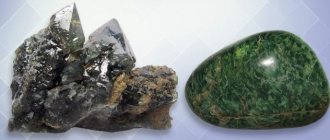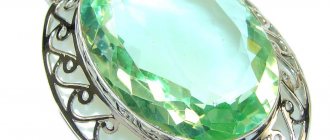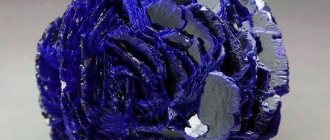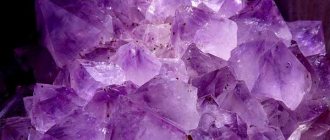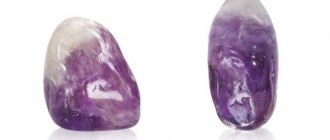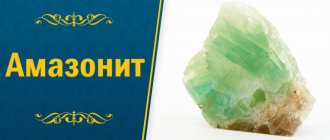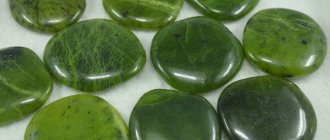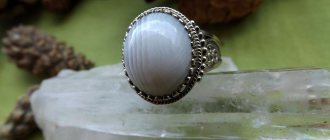Since the dawn of man, he has been surrounded by unusual stones and minerals, which delighted with their beauty, fascinated with their spectacular forms and therefore were endowed with magical properties. Rutile quartz is no exception.
The origin of the word "quartz" is not clearly defined, but perhaps it comes from the Vendian "twardy" hard. "Rutilus" literally translates to "reddish".
Rutile quartz is, in essence, ordinary quartz with the finest inclusions of rutile in the form of thread-hairs. The value of the stone depends on their thinness; the thinner they are, the more expensive the stone. According to the Mohs hardness scale, rutile quartz has a relative hardness characteristic of 6.5 -7.0.
History and origin
This stone has a long history. It begins in the closed priestly societies of Ancient Egypt and the sun-drenched cities of Hellas.
The hairy gem has an ancient nickname “Hair of Aphrodite” (or Venus - these are the same goddess).
Hellenic and Roman legend says that the goddess of love, Venus, once went to swim in a lake. There she accidentally dropped a strand of golden hair (apparently it got caught on something). The goddess returned to the lake only six months later, when it was covered with ice, and the golden strand had firmly grown into the ice crust.
Venus liked the look of golden curls frozen in ice so much that she turned the ice into transparent stone, forever leaving her hair as a gift to people.
Thanks to this legend, hairy quartz crystals went down in history as talismans of love. The myth of the locks of Venus was revived in the 17th–18th centuries, and the stone gained popularity among the upper echelons of the European (including Russian) aristocracy as a love amulet, a symbol of carnal passions unconstrained by obligations.
In a certain sense, the hairy man began to be considered a symbol of women's freedom in a patriarchal society. Freedom in the most important sense - the right to choose love for yourself.
Hairy quartz bracelet
Other names for the mineral are saguenite, “arrows of Cupid” or “arrows of love.”
In Muslim countries, with their love of poetry, the stone was called “the beard of the Prophet Mohammed” and specimens with black hairs were especially valued.
Currently, this mineral is valued mainly by collectors. Gem-quality samples (approximately 20% of all mined stones) are used to make jewelry.
Story
This jewelry material was extremely popular among the Greeks and Romans. The origin of the stone is always associated with the gods of love. The most common stories are about Venus and Aphrodite, which are almost no different from each other. The mineral is believed to be ice in which the hair of goddesses is encased. Therefore, this type of quartz has long been endowed with strong magical abilities.
However, over time, the popularity of the mineral decreased. For a long period of time, the existence of this stone was practically forgotten. He was even considered cursed and claimed that he develops in a person such qualities as rebellion and lust. But in the 17th century, rutile quartz regained its former fame among the upper class.
Physicochemical characteristics
The physical and chemical description of the stone is as follows: it is silica, silicon dioxide, like other types of quartz, for example, rock crystal. The “hair of Venus” owes its inclusions to rutile, titanium dioxide. In quartz, rutile forms hairs or thin needle-like formations “embedded” in a transparent solid mineral. Less common are combinations of triangles or irregular stars with many rays.
Rutile hairworm has golden-red or black inclusions. Sometimes you can find stones with “curls” of other colors - grayish, green, brown, red. These inclusions consist of goethite or actinolite; There are specimens pierced with black tourmaline crystals.
The physical properties of hair wool are similar to quartz:
- hardness - up to 7 according to Mohs, like untempered glass;
- luster - glassy (thanks to rutile - diamond);
- dielectric;
- insoluble in acids, except hydrofluoric acid, soluble in alkalis.
| Formula | SiO2 |
| Color | Colorless, gray, yellow, brown |
| Shine | Glassy, sometimes greasy in solid masses |
| Transparency | Transparent to translucent |
| Hardness | 7 |
| Cleavage | imperfect |
| Kink | conchoidal |
| Density | 2.6—2.65 g/cm³ |
Description and properties of hairworm
In mineralogy, hairy stone is quartz, a type of rock crystal with impurities and inclusions. The description of the stone always contains information about the nature of the inclusions. They impart color and signature patterns to the initially clear quartz.
“Venus hair” or other patterns in stone are formed by inclusions of rocks:
- rutile;
- tourmaline;
- ribikita;
- goethite;
- hornblende;
- actinolite;
- lepidocrocite.
Most often, rock crystal contains rutile inclusions. This titanium dioxide creates the finest crystals-columns, threads or needles in a transparent mineral. Their color range ranges from light yellowish to deep black. Orange specimens with a strong shine are highly valued by jewelers. Rutile is sometimes capable of a similar phenomenon. Due to its golden hue, the stone is known as rutile quartz.
The units are quite massive - the largest specimen after processing weighed a hundredweight, that is, 100 kg.
Varieties
There are no two identical hairworms in nature.
After cutting, each specimen acquires its own, unique design, so there is no clear classification by color and variety.
The bulk of the mineral is transparent white, like crystal, with contrasting inclusions. Stones with clear triangles or sharp-angled figures inside are called saguenites.
Quartz hairy saguenite
Specimens with black straight lines are “Cupid’s arrows” or “Cupid’s arrows,” but these names are colloquial. They are not used either in gemology or in jewelry.
Earrings with hairy quartz “Arrows of Cupid”
A special variety of the mineral is the Kola species, mined on the Kola Peninsula, in the Murmansk region of Russia. It is not as transparent as the others; it contains haze, like rauchtopaz, and white or grayish spots. The hairs and lines inside the Kola "hair of Venus" are green or black.
Unprocessed hairy quartz, Kola species
Less common are hairworms of red, yellow or light green colors.
Red hairy quartz
Varieties of rutile quartz
Hairy quartz has different shades, among the most common are:
- Saguenite - a pattern similar to triangles or other pointed shapes.
- Cupid's arrow (unofficial name) is a hairy plant with dark inclusions.
- The Kola hairworm received its name in honor of the place of production - the Kola Peninsula. This variety is characterized by increased transparency, smokiness and the presence of additional spots, in addition to black or green hairs.
- Multi-colored mineral options combine green, red and yellow stripes.
All of the above options, except Kola, have unique transparency. The shades of the gem are obtained only due to the color of the inclusions.
Mining locations
Rutile quartz is a common mineral, as are other types of silicas.
The extraction of hairworms of different colors is carried out:
- in Brazil;
- Russia - on the Kola Peninsula and in the Subpolar Urals;
- Kazakhstan;
- Norway;
- USA;
- Australia;
- Pakistan.
“Cupid's arrows” - stones with inclusions of black tourmaline, that is, schorl - are mined mainly in the Urals and Brazil, with smaller quantities coming from Pakistan. The “star-shaped” hairworm comes from Brazil.
Place of Birth
In our country at present it is practically not found; deposits are located in America, Brazil, Madagascar, and Australia. Certain subspecies of rutile quartz, for example, “arrows of the Amur,” can be found in the northern regions of the Urals and Pakistan.
Jewelry-quality stones are mined in Norway and the Subpolar Urals. Deposits of rutile quartz with an admixture of goethite are concentrated in Kazakhstan.
Medicinal properties
The healing properties of hairweed are associated with the projective energy of yang and the solar plexus chakra.
Physically, it has a beneficial effect on the organs of the digestive tract located at the level of this chakra. Among them:
- stomach;
- pancreas;
- liver;
- spleen.
In spiritual and psychological terms, rutile quartz, like other minerals associated with this chakra, has a beneficial effect on a person’s imagination and his emotional spectrum - towards ordering. Hairy helps to put thoughts in order, sift out the necessary from the unnecessary (separate the lambs from the goats), treats chronic fatigue syndrome.
The specific properties of this gem include activation of the immune system. A number of lithotherapists claim that hairworm helps the body recover from radiation exposure. They recommend wearing an amulet made from this stone in case of chronic radiation sickness (in a mild form).
There is evidence that wearing this stone in any frame helps with baldness, being a preventive measure.
For the fair sex, the mineral is useful for the prevention of hormonal imbalances that can lead to menstrual irregularities. Pink or reddish quartz treats colds and some problems with the bronchi.
Magic properties
The magical properties of the stone are concentrated in two areas: firstly, it is an amulet that helps in matters of the heart, and secondly, it is a strong talisman that sharpens the intuition and visionary abilities of its owner.
Hairy quartz in a gold ring
The caste of priests of the “country of Kemet,” that is, Ancient Egypt, used the magical properties of rutile quartz in arcana, which made it possible to foresee upcoming events. The hairworm helped predict the results of the war, the chances of a good harvest next year, the likelihood of recovery from the pharaoh's illness, and much more.
Rutile inclusions increase the magical power of any stone, including quartz.
In Ancient Greece, it was believed that veins in the form of hair and thin threads symbolize precisely those threads with which the Moira, the spinners of fate, weave the fate of every mortal. They are directed from the past to the future, but at the same time have a clear beginning and end.
If a ring with a hairy hair is worn on the left hand, the wearer will be able to predict the upcoming events of his own life and the lives of those around him.
Another area of influence of rutile quartz on reality is amorous affairs, carnal love and a happy marriage.
Since the Renaissance, there has been a belief that wearing jewelry with hair is good for a girl’s marriage. He is especially favorable to beautiful ladies who want to find their own life partner. Therefore, the stone is used in love magic to create love spells, and also as a basis for love amulets.
Hairy does not like to be used for too long. He must be “given a break” from the person, otherwise the beneficial effect of the stone will turn negative.
Rutile quartz (hairy)
Rutile quartz (hairy quartz) is a mineral of fascinating beauty and unusualness, the transparent sphere of which is pierced by thin lines of inclusions.
It is the inclusions that make this stone so interesting to contemplate. Different shades, they will always be located in a new way. You will never find another stone like it. The density and arrangement of the threads will be new each time.
The icy transparent sphere of the mineral contains a mysterious world. The golden threads inside are called “hair of Venus”
, and dark ones -
“arrows of Cupid”
. Sometimes it’s as if a feather is hiding in the stone, and sometimes it really seems like the heroine of Botticelli’s paintings has just been here, dropping a golden strand.
Physical properties of rutile quartz (hairy quartz).
- Formula
: SiO2.
- singonia
: trigonal.
- Hardness
(Mohs scale): 7. (On a scale from 0 to 10, where 10 is the hardest stone, diamond).
- Density
: 2.6 g/cm3.
Rutile quartz is a type of silicon dioxide. Among other types of quartz, it stands out due to the presence of thin inclusions. Inclusions resembling threads and needles give the mineral a special charm. The inclusions are titanium dioxide of a brown or golden hue. Sometimes the color may be silver or greenish. They can also be found in other minerals, primarily of the quartz group - amethyst, rock crystal, rauchtopaz.
Dark-colored inclusions, which are usually called “Cupid's arrows,” belong to tourmaline hairworms, but they are also classified as quartz – hairworms.
History of rutile quartz (hairy quartz).
The name of the mineral comes from the word " rutilus "
- “golden”, “red”.
Quartz with such golden inclusions is called “hair of Venus
.
But if the inclusions are dark, then these are “Cupid’s arrows”
(“Cupid’s arrows”). Also, this mineral is called “arrows of love.”
Rutile quartz was known back in Ancient Egypt. The priests resorted to the help of the hairy creature when performing their mysterious rituals. European medieval alchemists also widely used it in various magical actions and love spells. This mineral was considered a powerful love spell.
In the East, hairs with dark inclusions were declared sacred. Muslims believed that the stone contained a piece of the beard of the Prophet Muhammad.
Deposits of rutile quartz (hairworm).
Deposits of rutile quartz are scattered throughout the world. The most famous are in Australia, Brazil, USA, Norway, Pakistan, Kazakhstan
.
Rutile quartz is also mined in Madagascar
.
How to care for rutile quartz (hairy) jewelry.
Hairworm belongs to the quartz group of minerals, and therefore has enviable hardness. 7 points on the Mohs scale indicate that there is little fear of mechanical damage to the stone. However, it still needs to be handled with extreme care. Store jewelry containing rutile quartz separately from other items and remove it before doing housework or sports. Make sure that detergents and cleaning agents, as well as cosmetics, do not come into contact with the surface of the stone.
Magical properties of rutile quartz (hairy quartz).
Rutile quartz (hairy) banishes depression, irritability, fears
.
It helps relieve the owner from loneliness
.
This is a slightly magical mineral; it is not for nothing that ancient priests and alchemists loved it so much. Rutilated quartz can clarify the future
and sharpen
intuition
.
The hairworm is a powerful amulet; it seems to cover the owner with a protective shield, which becomes an obstacle to envy, black magic, and negativity.
The most important magical quality of rutile quartz is to attract strong mutual love
.
It acts as a relationship magnet
, enhancing women's attractiveness, beauty and influence over men. Golden rutile quartz exhibits these features especially strongly. Not without reason, in ancient times it was used as a love amulet, a real love spell.
The healing properties of rutile quartz (hairworm).
Rutile quartz has a powerful rejuvenating effect
on the body, it slows down aging and activates defenses.
Hairworm supports and strengthens the immune system
.
In addition, it helps to get rid of depression, fears, and nervous disorders.
.
The mineral will help its owner overcome fatigue. Also, rutile quartz actively fights various colds and ARVI
.
Who is rutile quartz (hairy) suitable for according to their zodiac sign?
Rutile quartz will be the most powerful amulet for Taurus, Libra, Gemini
.
Rutile quartz (hairy quartz) has incomparable magic. The mysterious threads inside the crystal sphere leave no one indifferent! I would like to admire this decoration endlessly. And if you remember about the strong magical properties of hairworm and its ability to attract love into life and protect from the negative influence of others, then it becomes clear that this mineral should definitely be added to your jewelry collection!
Author: Anna Solovyova.
Photographer: Inna Kubareva.
Check out our exclusive products with this stone
Zodiac compatibility
Hairy is an undemanding stone, suitable according to the sign of representatives of all elements, except for the fire sign of Aries. But this does not mean that the “hair of Venus” will harm him - rather, they simply will not help.
Hairy quartz pendant
The gem has special meaning for the signs of Taurus and Gemini.
| Zodiac sign | Compatibility |
| Aries | — |
| Taurus | +++ |
| Twins | +++ |
| Cancer | + |
| a lion | + |
| Virgo | + |
| Scales | + |
| Scorpion | + |
| Sagittarius | + |
| Capricorn | + |
| Aquarius | + |
| Fish | + |
Which zodiac signs is rutile quartz compatible with?
No matter how ideal this Rutilated Quartz stone is, it is not suitable for all individuals. If magical properties are very important, then note that there are designer accessories with quartz. They look very unusual and attractive, because often beautiful engravings are placed on them, and other stones or metals are selected for the perfect combination. Based on astrology and the recommendations of magicians, Rutilated quartz will be an excellent decoration for individuals born under the following zodiac signs:
- Aquarius;
- Taurus;
- twins;
- virgins
For Taurus, Rutile helps improve their mental state and find complete harmony within. Gemini will be able to reveal unexplored talents and learn to cope with their internal differences.
Other zodiac signs are not contraindicated from wearing Rutile. Just know that its properties will be less pronounced.
Compatibility with other minerals
Like most types of quartz, hairworm is strongly associated with the element of Air. He is friends with Fire, whose power he supports and feeds, cannot interact with Earth and maintains armed neutrality with Water. Air either does not interact with the last element in any way, or causes disturbances - even a storm. For the carrier person, this is fraught with loss of luck, deterioration in well-being and other problems.
Cupid's Arrows are compatible with the following minerals:
- garnets (almandine, pyrope, grossular, demantoid, uvarovite);
- rock crystal;
- heliodor;
- coral;
- pyrite;
- rauchtopaz;
- amethyst;
- citrine;
- chrysoprase;
- amazonite;
- golden beryl;
- fluorite;
- tourmaline.
Hairy quartz and rock crystal pendant
Neutral combination:
- with stones of the chalcedony group;
- turquoise;
- malachite;
- jadeite;
- jasper;
- sarder;
- heliotrope;
- jet;
- cacholong;
- morion (black quartz);
- rhodochrosite;
- lapis lazuli.
Ring with lapis lazuli and hairy quartz.
The hairy one will behave negatively in the company of:
- with emerald;
- topaz;
- alexandrite;
- aventurine;
- pearls;
- euclase;
- peridot;
- sapphire;
- chrysoberyl.
Compatibility with Zodiac signs
Rutile quartz is suitable for most zodiac signs. The most favorable combination is with Taurus, Gemini, Cancer, Leo, Libra and Aquarius. The stone will help representatives of these zodiac signs quickly gain strength, find inner harmony and develop their best qualities. It minimizes negative traits, making such a carrier more attractive.
This variety of quartz has a moderate positive effect on all remaining signs of the Zodiac, except Aries. People belonging to this zodiac sign will not be able to receive support from the amulet due to too great a difference in energy.
Compatibility with other stones
The hairworm belongs to the element of Air, but is friendly. There are many stones that are ideal for combination, including:
- pyrite;
- rhinestone;
- rauchtopaz;
- citrine;
- pyrope;
- amethyst;
- grossular;
- demantoid.
However, it must be taken into account that rutile quartz has a negative relationship with some minerals. For the amulet to be beneficial, the stone cannot be combined with topaz, sapphire, emerald and chrysoberyl. You should also avoid combining with pearls and aventurine, as they will absorb the energy of the hairworm.
Application area
Hairy quartz bracelet
The stone is used as a valuable collectible. Jewelry-quality specimens, with rich colors and characteristic patterns, are used for jewelry. They are used to make bracelets and beads, and some samples are set in precious metals - silver, white and yellow gold.
The rule applies: stones of a golden hue, with orange, yellow or red veins, are framed in yellow gold.
Foggy gray, with silver, black and, less often, green inclusions - in silver or white gold. Platinum is not used.
Since quartz is a fairly durable mineral, figurines, figurines, and various esoteric paraphernalia are made from it.
In the past, seals were cut out of hairs.
Classic cut shapes are cabochon, stepped or beveled (wedges).
Varieties and colors of hairworm
“Hair of Venus” is the most unusual and expensive type of rock crystal, that is, transparent quartz. Impurities and inclusions color the base, creating the following types of hair:
- rutile - specimens with golden or red tints;
- tourmaline - reminiscent of greenish moss or grass frozen in ice;
- saguenite - stones with triangle inclusions visible to the naked eye that move when rotated;
- Kola - opaque, with white or grayish spots on the surface and dark green needles inside the mineral.
The Kola variety of stone is named after the place of extraction (Russia, Kola Peninsula). It is created by aegirine impurities. Minerologists consider this species to be an independent low-value rock, and not quartz.
The color of the needle-like formations inside the hairy mineral is not only classic gold. There are other shades:
- dark - with tourmaline, hornblende or schorl;
- silver - the shade is created by dense accumulations (sometimes white) of asbestos;
- yellow or yellow-brown – goethite additives;
- green – actinolite impurities.
Green pebbles are the most beautiful and unique. The needles in the mineral form patterns or drawings, the analysis of which is reminiscent of a Rorschach test - everyone sees something different in them.
How to spot a fake
Volosatik is an ornamental stone, although it is quite valuable. It is rarely counterfeited, but counterfeits do occur. Basically it is glass with artificial inclusions.
Gold ring with hairy quartz
The best way to check the naturalness of a stone is to evaluate the arrangement of the threads. Forms that are too regular should alert you: in natural stone, the “hairs” are arranged chaotically, scattered. “Arrows of Cupid” are equal in hardness to glass, so assessing the hardness, which you can do in a store yourself, will not yield anything.
The best way to protect yourself from counterfeiting is to purchase rutile quartz only in trusted, large stores.
Jewelry and decorative mineral
The value of a gem as a jewelry material depends on the density, color and whimsicality of inclusions.
- The highest price for classics are rutile and tourmaline specimens with golden, green or black tints.
- Original jewelry with movable triangle inclusions is made from saguenite. The stones are valued by jewelers for their ability to create large, massive objects.
- The Kola variety of the mineral is considered decorative. From it, stone carvers make small plastic pieces, office table sets, boxes, picture frames or photo frames. Stone decoration of fireplaces, panels or furniture looks interesting.
The European nobility loved Volosatik since the 18th century. Pendants, bracelets, beads, and buttons made of hairy quartz were popular. A unique artifact made of rutile quartz is preserved in the Hermitage treasury - the family coat of arms of the Chertkov nobles.
The pebble is still in favor today. Jewelers process it as a cabochon, in which the pattern and color appear in all their glory. Round and facet-shaped inserts or independent fragments of jewelry made of hair are also used.
To accentuate the features of the stone, it is framed with metal of the appropriate color:
- yellow (gold) – specimens of the brown-golden color scheme;
- white (silver or gold) – silver and black stones.
We recommend reading: Opportunities and energy of pink topaz
A stone “patterned from the inside” is rarely combined with other gems in jewelry, because it is good on its own.
Specimens with light inclusions—“hair of Venus”—are considered female, while specimens with dark “arrows of Cupid” are considered male. Caring for the stone is simple, just like regular quartz. Protect from falls, household chemicals, and bright sun.
The structure protects the hair from fakes - reproducing the chaos created by nature is difficult, expensive, and therefore unprofitable.
How to wear and care
This gem is quite durable and therefore does not require special care. Store it separately from other minerals in your stone or jewelry collection - in a special section of the box or simply in a soft bag. When wearing, protect from impacts.
You can wash the stone with ordinary soapy water and a hard sponge. You can use household chemicals, but only those that do not contain alkalis - acid-based.
The magical power of the hairworm requires periodic recharging. To do this, place the stone in running or melt water for 6 hours (from the tap will not work). After this, dry it and place it in direct sunlight for one to two hours.
The magic of the stone varies depending on how it is worn. Wearing it on the left hand opens up the ability to foresight and at the same time contributes to the preservation of an existing marriage (or simply a stable relationship). Wearing it on the right hand, on the contrary, attracts new love.
For something new to come into life, the old must leave it. A hairworm worn on the right hand can destroy your current relationships in order to invite new ones into your life.
